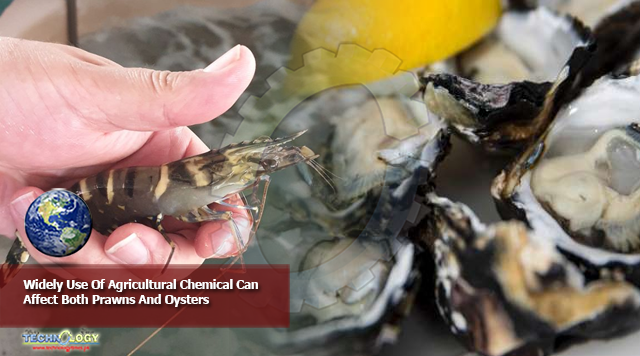New research by Southern Cross University into pesticide run-off has revealed that a widely used agricultural chemical can affect both prawns and oysters.

Scientists at the National Marine Science Centre in Coffs Harbour on the New South Wales North Coast found that imidacloprid — which was approved for use in Australia as an insecticide, fungicide and a parasiticide — could impact the feeding behaviour of prawns.
Centre director Kirsten Benkendorff said of the seafood species they were particularly concerned how the water soluble pesticide would affect prawns.
“They’re closely related to the insects and so we did hypothesise that they might be very susceptible to the insecticides and that’s definitely what we found,” she said.
A laboratory-based study demonstrated that exposure to the pesticide, through contaminated water or feed, could result in nutritional deficiency and reduced flesh quality of black tiger prawns.
“The environmental concentrations that we detected were up to 250 micrograms per litre, and the prawns and oysters were impacted down at around 1 to 5 micrograms per litre in terms of sub-lethal effects,” Professor Benkendorff said.
“The prawns actually do start dying at around the environmental concentrations [of] 400-odd micrograms per litre.
“It’s what we refer to as the LC50, or the lethal dose 50, where you’d expect 50 per cent of the population to die.”
But researchers also found in a separate study that exposure to the neonicotinoid could also weaken the immune system of Sydney rock oysters.
“So the effects on the prawns at really quite low concentrations are quite serious and the oysters are more resistant than the prawns,” Professor Benkendorff said.
“But we definitely saw impacts on their immune system which means they’d be likely susceptible to disease.”
The research also looked at how the pesticides accumulated in the flesh of both prawns and oysters.
“That’s certainly something for concern from the perspective that they do take them up from the environment,” Professor Benkendorff said.
“And then those pesticide residues are in the flesh that we then potentially eat.”
She said while further study was needed the research identified the need for effective management of pesticide use and run-off in coastal areas.
NSW fishing industry ‘extremely alarmed’ by research
The Professional Fishermen’s Association of NSW chief executive Tricia Beatty says the research raises a red flag and that the NSW Government should take immediate action.
“Our industry has been saying for years now that we’re very concerned about the chemical impact upstream of our industry,” she said.
“Our industry’s worth $500 million to the NSW economy, but, not just that, we’re also the backbone of many of the coastal regional communities.
“Australia needs to take a hard look at what’s going on in Europe with the ban of these types of chemicals and replicate it here.”
The industry is also concerned that the pesticide can affect other marine species.
“Not just on other crustaceans and molluscs but across the food chain; many species within our estuaries eat those prawns,” Ms Beatty said.
Neonicotinoids pesticides — which are banned in France and the European Union since 2018 — have been under review by the Australian Pesticides and Veterinary Medicines Authority (APVMA).
The APVMA said that it commenced the review in 2019 “following the evaluation of new scientific information about risks to the environment, and to ensure safety instructions on products meet contemporary standards”.
A proposed regulatory decision is expected to be published by April 2021 followed by three months of consultation before a final decision into the chemical is made.
Berry industry defends its use of pesticide
While researchers point to berry growers as one of the main users of imidacloprid on the Coffs Coast, the industry’s peak body has defended its use of the chemical.
Berries Australia executive director Rachel Mackenzie says it must be recognised how widely used the chemical is.
“It’s in Baygon, it’s in flea control that people use for their dogs, it’s widely used in termite control for new developments; this is not a berry issue,” she said.
Originally published at Abc net